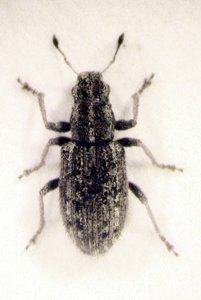Pests
Sitona crinitus Hrbst. - spotted pea weevil.
Systematic position.
Class Insecta, Order Coleoptera, Family Curculionidae, Genus Sitona. Closely related to S. crinitoides.Biological group.
The pests of leguminous grain crops and perennial leguminous grasses.Morphology and biology.
Body length, 2.8-4.5 mm. Eyes large, moderately convex with eyelashes along upper margin. Pronotum noticeably narrower than elytra, densely and coarsely punctuate. Elytra with strong humeral prominences, body covered with big rounded grayish and white scales without metallic shine. Interstriae of elytra have long setae. Base part of 6th, 8th interstriae, part of 3th, 7th and whole 5th, 10th interstriae are usually whitish. Tibiae and tarsi are reddish. Mating and oviposition occur from spring until the end of June and then beetles die. Produce no more than 2000 eggs. Females lay whitish-yellow eggs on plants or soil surface. Eggs develop in 7-36 days depending on the temperature. Larvae feed on root tubercles and develop in 30-45 days. Pupation occurs in soil at a depth of 10-15 cm at the end of June and the beginning of July. The pupa development lasts 8-11 days.Distribution.
Sitona crinitus inhabits all of Europe, Turkey, Israel, Afghanistan and was introduced into the USA. In the former USSR it is widely distributed from the southern border to latitude 63-64°N in the European part and 56-58°N in the Asian part.Ecology.
It is one of the most broadly oligophagous species in the pea weevil group. In the wild it lives on esparcet, Astragalus sp. and more rarely on lucerne, cat's clover, Arctic clover, crown vetch, clover, woodwaxen, vetch. In agriculture it prefers esparcet, lentil and alfalfa. Moderately xerophilous. Everywhere monovoltine. Spring activity of the beetle starts begins with an average air temperature of 12-14°C. Ground migrations start with the beginning of perennial leguminous vegetation and flight activity begins when the shoots of leguminous grasses appear. The greatest intensity of adult feeding occurs in May-June. Population density in the wild depends on the activity of entomophages, e.g., predators Harpalus pubescens Mull. and Philonthus ebeninus Grav and parasites of adult beetles Pygostolus falcatus Nees., Perilitus labilis Ruthe. All phases of insect development may be infected by mycosis of Mycetosporidium spp., adult beetles by "white fungus" Beauweria bassiana (Bals.), and larvae and pupae by Metarrhizium anisopliae (Metsch.).Economic significance.
Spotted pea weevil causes the greatest damage to lentils when shoots appear. In such periods numerous weevils migrate to lentils from perennial leguminous grasses. Elimination of root tubercles by larvae decreases the nitrogen accumulation rate in plants and soil. Feeding of adults and larvae on leaves and roots during dry and hot springs decreases the harvest significantly. Sometimes Spotted pea weevil is erroneously determined to be the pest of beet crops, which it uses only as shelter. Control measures include sowing the annual leguminous plants for grain at the earliest time; using fertilizations for the first five weeks (encourages acceleration of leaf development); sowing the annual leguminous plants for grain after sowing the perennial leguminous grasses in crop rotation; plowing fields after harvesting; insecticide treatments of plants on attractive strips after harvesting.Reference citations:
Freude H., Harde K.W., Lohse G.A. 1981. Keys to families and genera for adult males and females. Krefeld: Goecke & Evers. 310 p. (In German)Grossheim N.A. 1928. Materials for the study of the Genus Sitona Germ. Proceedings of Mleev Horticultural Experiment Station. Mleev: NKZS-Ukr. SSR. N. 17: 57. (In Russian)
Petrukha O.I. 1969. The pea weevils of the genus Sitona Germ. of the USSR fauna, damaging leguminous crops. Leningrad: Nauka. 255 pp. (In Russian)
Shchegolev V.N., ed. 1955. Agricultural Entomology. Leningrad-Moscow: Gos. Izd. Selskokhoz Lit. 616 pp. (In Russian)


